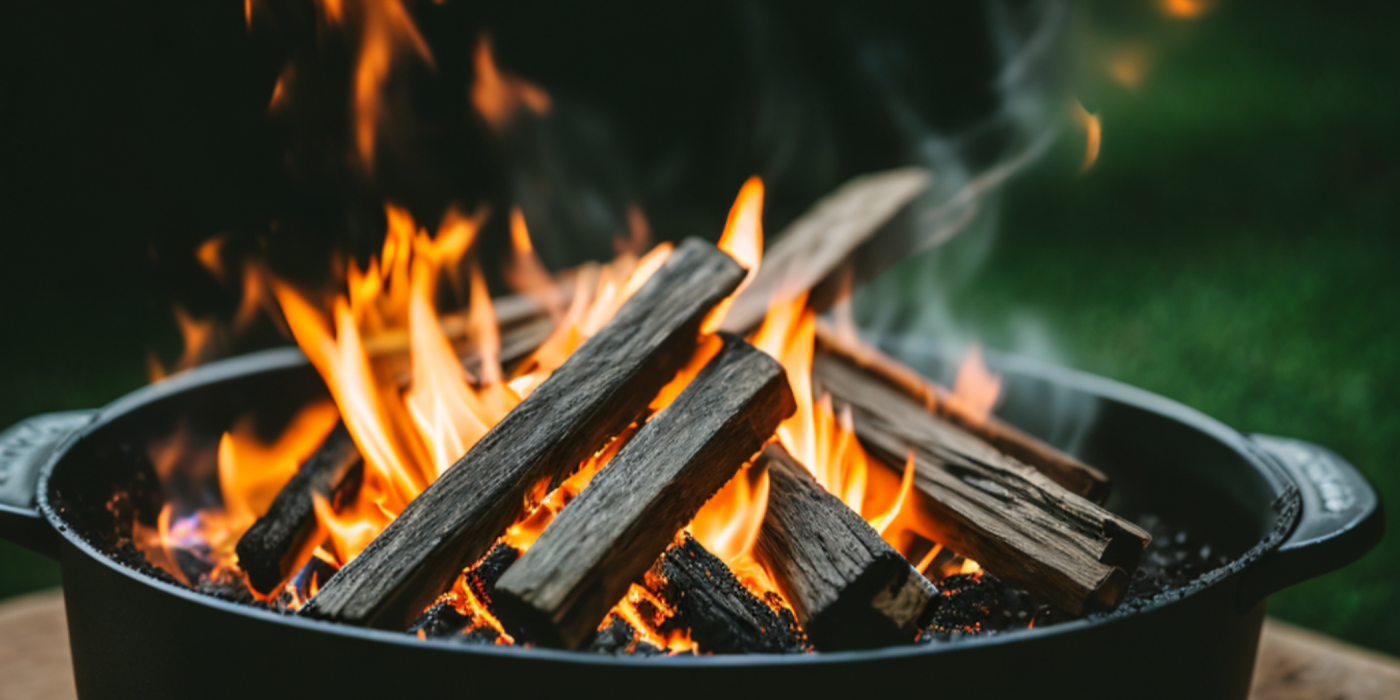How to Stop Your Fire Pit from Smoking

Fire pits are a brilliant addition to any garden, providing warmth, ambience, and a perfect setting for social gatherings. However, one common issue many fire pit owners encounter is the production of smoke. This isn't merely a minor inconvenience, but can significantly detract from the otherwise pleasant experience of sitting around a fire pit. The problem extends beyond causing watery eyes and a persistent cough, as smoke can create a multitude of other issues, both for us and our environment.
The Impact of Smoke
Smoke contains a mixture of gases and microscopic particles that, when inhaled, can lead to serious health problems, especially in those with respiratory conditions. Further, the excess smoke can be a nuisance to neighbours and even violate local regulations in some cases. From an environmental standpoint, the production of smoke contributes to air pollution, becoming a larger concern as we increasingly strive to adopt more sustainable practices.
Aim and Scope of this Guide
This article aims to provide effective solutions to minimise the smoke from your fire pit, turning it into a more enjoyable and eco-friendly feature of your outdoor space. We will delve into the types of fuels you should be using, discuss the proper technique for building a fire, highlight the importance of ventilation, and touch on the essential aspect of regular maintenance. Additionally, we'll review some smokeless fire pit models available in the UK market for those looking for a ready-made solution. By the end of this guide, you'll be armed with the necessary knowledge to stop your fire pit from smoking and enjoy those cosy outdoor gatherings without any downsides.
The Science Behind Fire Pit Smoke
How and Why Fire Pits Produce Smoke
Smoke is produced when organic matter, such as wood, doesn't completely combust or burn. In a fire pit, this incomplete combustion usually happens due to the lack of sufficient oxygen or heat, or because the fuel is too dense or not properly dried.
Combustion Process
To better understand this, we can delve into the combustion process, which involves three crucial elements: fuel (in this case, wood or similar), heat, and oxygen. This is often referred to as the fire triangle. A balanced combination of these elements leads to efficient combustion, which results in flame, water vapour, carbon dioxide and ash, with minimal smoke.
Incomplete Combustion
However, when one of these elements is lacking or not in the right proportion, we get incomplete combustion. This causes the unburned carbon particles to escape in the form of smoke, creating that familiar but unwanted plume above your fire pit.
Impact of Smoke on Health and the Environment
Smoke can have several negative effects. From a health perspective, it can irritate your eyes, throat and lungs, leading to coughing, wheezing, and even exacerbating conditions like asthma.
Environmental Concerns
Environmentally, smoke contributes to air pollution and carries fine particulate matter, which when breathed in, can cause health issues. It's also worth noting that smoke can be a nuisance to your neighbours, potentially leading to complaints or disputes.
Understanding the science behind smoke can help you make changes to your fire pit setup and usage, enabling you to significantly reduce the amount of smoke produced. This results in a more enjoyable, healthier, and neighbour-friendly fire pit experience.
Choosing the Right Fuel
The choice of fuel plays a crucial role in the amount of smoke a fire pit produces. By selecting the appropriate fuel, not only can you enjoy a warmer, longer-lasting fire, but you can also significantly reduce smoke production.
The Role of Wood
While many people may opt for whatever wood they have on hand, not all wood is created equal when it comes to smoke production.
Dry, Seasoned Wood
The best choice for a low-smoke fire is dry, seasoned wood. 'Seasoned' means that the wood has been left to dry for at least six months, and sometimes up to two years. This process allows the water inside the wood to evaporate, making it burn more efficiently and produce less smoke.
Kiln-Dried Wood
Another great option is kiln-dried wood. This type of wood has been dried in a kiln, removing virtually all moisture. This results in a very clean burn with minimal smoke. While it can be more expensive, the benefits of reduced smoke and a more efficient burn can make it worth the investment.
Smokeless Fuel Alternatives
In addition to wood, there are other fuel options that can lead to a smokeless fire pit experience.
Gas and Bio-Ethanol
Gas fire pits, while requiring a different setup, can offer a smoke-free solution. Similarly, bio-ethanol is a renewable energy source that burns cleanly and produces no smoke. These alternatives may require an initial investment but provide a reliable and environmentally friendly solution to the smoke problem.
In conclusion, the right fuel can make all the difference in your smoke production. Whether you opt for seasoned or kiln-dried wood, or smokeless alternatives like gas and bio-ethanol, your choice can significantly enhance your fire pit experience.
Proper Fire-Building Techniques
Building a Fire Correctly to Reduce Smoke
Building a fire properly is an essential technique to significantly reduce smoke. The way you arrange your wood can have a profound impact on the amount of smoke produced. The goal is to ensure the wood burns as efficiently as possible, which in turn minimises the smoke.
Efficient Burning
To achieve efficient burning, begin by ensuring that your fire pit is clean and free from any wet or partially burned wood from previous fires. Use smaller, kindling wood to start the fire. As the kindling catches, gradually add larger pieces of wood. Avoid adding too many large pieces at once as this can suffocate the fire and cause excess smoke.
Importance of Arranging the Wood Properly
The arrangement of wood within the fire pit also plays a significant role in smoke production. Pieces of wood should not be too tightly packed together as this restricts airflow, which is crucial for efficient burning. Instead, stack the wood in a way that allows good air circulation. A crisscross or teepee pattern often works well.
Optimal Wood Arrangement
The wood should also be stacked with the largest pieces at the bottom and progressively smaller pieces layered on top. This setup aids in creating a hot, intense fire that can efficiently burn larger pieces of wood, further reducing smoke.
The Top-Down Fire-Building Method
The top-down method, also known as the 'upside-down' method, is an effective fire-building technique for reducing smoke. In this method, the largest logs are placed at the bottom of the fire pit, with smaller logs, kindling, and finally tinder layered on top. When the fire is lit from the top, the smaller material burns first and gradually ignites the larger logs below. This technique provides a long-lasting, efficient fire that minimises smoke.
The Importance of Proper Ventilation
The Role of Ventilation in Reducing Smoke
In your quest to enjoy a smoke-free fire pit experience, understanding and improving ventilation is crucial. Proper ventilation aids in the efficient burning of fuel, thereby reducing smoke. A well-ventilated fire pit ensures a steady supply of oxygen, which is necessary for combustion. When the oxygen supply is optimal, the fuel in your fire pit burns more completely, producing less smoke in the process.
Combustion and Ventilation
Combustion is a chemical process involving oxygen and it's essential in burning fuels efficiently. Incomplete combustion due to insufficient oxygen supply leads to increased smoke as more particulate matter is released.
Improving Ventilation in Your Fire Pit
Improving your fire pit's ventilation can be achieved through several methods. Firstly, ensure that your fire pit is not overly filled with fuel. An overly packed fire pit may restrict the flow of air, leading to inefficient burning and thus, more smoke.
Proper Fire Pit Positioning
Positioning is another factor to consider. Your fire pit should be positioned in an open area where wind can provide natural ventilation. Be mindful, however, of too much wind, as it can cause the fire to burn unpredictably.
Fire Pit Design and Maintenance
Fire pit design can also influence ventilation. Some models come with built-in air vents that improve airflow. Regular maintenance, such as removing ash and debris that may clog these vents, is vital for maintaining good ventilation and hence, minimising smoke.
In conclusion, proper ventilation plays a significant role in reducing smoke from your fire pit, making your outdoor fires more enjoyable and environmentally friendly.
Regular Maintenance and Cleaning
Regular maintenance and cleaning is not just essential for the longevity of your fire pit, but it also plays a crucial role in reducing smoke.
The Importance of Regular Cleaning
One of the main reasons fire pits produce smoke is due to the incomplete combustion of wood. If your fire pit is full of ash and residue, it could hinder the proper airflow necessary for complete combustion. In other words, a dirty fire pit is likely to create more smoke because the fire isn't getting the oxygen it needs to burn efficiently.
Ash Buildup
Over time, ash and soot buildup can clog the airflow passages and lower the efficiency of your fire pit. This not only results in more smoke but also means your fire pit won't produce as much heat.
Step-by-Step Guide to Cleaning Your Fire Pit
To ensure your fire pit continues to function at its best, it is advisable to follow these steps for cleaning:
Step 1: Let the Fire Pit Cool
Before starting the cleaning process, always ensure the fire pit has cooled completely. This can typically take several hours after the fire has been extinguished.
Step 2: Remove the Ash and Debris
Once the fire pit is cool, remove the ash and other debris using a shovel or scoop. Be careful not to scratch or damage the fire pit surface.
Step 3: Clean the Interior
After removing the bulk of the debris, clean the interior of the fire pit with a wire brush to scrub off any remaining soot or residue.
Step 4: Rinse and Dry
Finally, rinse the fire pit with water and let it dry thoroughly before using it again.
Regular maintenance can significantly reduce smoke and provide you with a better, more enjoyable fire pit experience.
Review of Smokeless Fire Pit Models
The Concept of Smokeless Fire Pits
Smokeless fire pit models are a true game-changer in outdoor heating. They are designed with unique features that help to significantly reduce the amount of smoke produced, allowing you to enjoy a cosy fire without the irritation of smoke. The concept lies in the unique build of these models, which enables better combustion, hence less smoke. They utilise the heat produced to burn off the smaller smoke particles before they have a chance to escape, thereby reducing the amount of smoke generated.
Advantages of Smokeless Fire Pits
Smokeless fire pits offer a cleaner, more enjoyable experience. Apart from being better for your health and the environment, they also offer increased fuel efficiency, making them a cost-effective solution in the long run.
Top Smokeless Fire Pit Models in the UK
Several models have become popular in the UK market, each with its own unique features and advantages.
BioLite FirePit+
The BioLite FirePit+ offers a smokeless experience by maximising the airflow. It utilises 51 air jets that intensify the heat and reduce smoke. Plus, it features an X-Ray mesh that offers a 360-degree view of the fire.
Solo Stove Bonfire
Known for its double-wall construction and unique airflow properties, the Solo Stove Bonfire ensures efficient combustion, thus dramatically reducing smoke.
TIKI Brand Fire Pit
The TIKI Brand Fire Pit features an internal airflow system that feeds the fire while reducing smoke. It also boasts a stylish design and durable construction.
Each model offers unique features and benefits, and selecting one should depend on your specific requirements and preferences.
Recap of Smoke-Reducing Techniques
In this in-depth guide, we've unearthed several effective techniques to tackle the issue of smoking fire pits. It all starts with the proper choice of fuel – dry, seasoned wood, kiln-dried wood, or smokeless alternatives such as gas and bio-ethanol can significantly reduce the smoke produced.
Fire-Building and Ventilation
We've delved into the art of proper fire-building, highlighting how a well-arranged, top-down fire can minimise smoke. Furthermore, ensuring good ventilation in your fire pit is essential, not just for the health of the fire, but also for keeping smoke levels in check.
Maintenance and Smokeless Models
Finally, regular maintenance and cleaning of your fire pit play an integral role in smoke reduction. For those seeking an upgrade, we've also explored some of the top smokeless fire pit models in the UK market that are designed to keep smoke at bay.
Benefits of a Smokeless Fire Pit Experience
A smokeless fire pit experience is not only a breath of fresh air for you but also for the environment. By reducing smoke, you mitigate health risks, curb air pollution, and create a more pleasant ambiance, free from the disruptive scent and sight of heavy smoke.
Encouraging Responsibility and Eco-Friendliness
As we conclude, let's remember that the enjoyment of a fire pit should not compromise our commitment to environmental sustainability. As fire pit users, it is our duty to adopt and promote responsible, eco-friendly practices that ensure our leisure activities respect the environment. A smokeless fire pit experience is indeed the way forward.
Related to this article are the following:
I do hope you have enjoyed this article and hope that you will subscribe to my newsletter so you can get the latest information about all things naturally relaxing.
Stay in touch, join the Naturally Relaxing Newsletter
Newsletter Signup
Post Your Comments
or post as a guest
Be the first to comment.
Latest articles in Relaxation

Capturing the Perfect Sunset: Tips and Techniques

The Benefits of Aromatherapy: Essential Oils for Relaxation

Embracing Calm: Innovative Ways to Relax in the New Year

Autumn Aromatherapy: Essential Oils for Relaxation

Embracing Autumn's Tranquillity: Finding Peace in the UK's Golden Season






